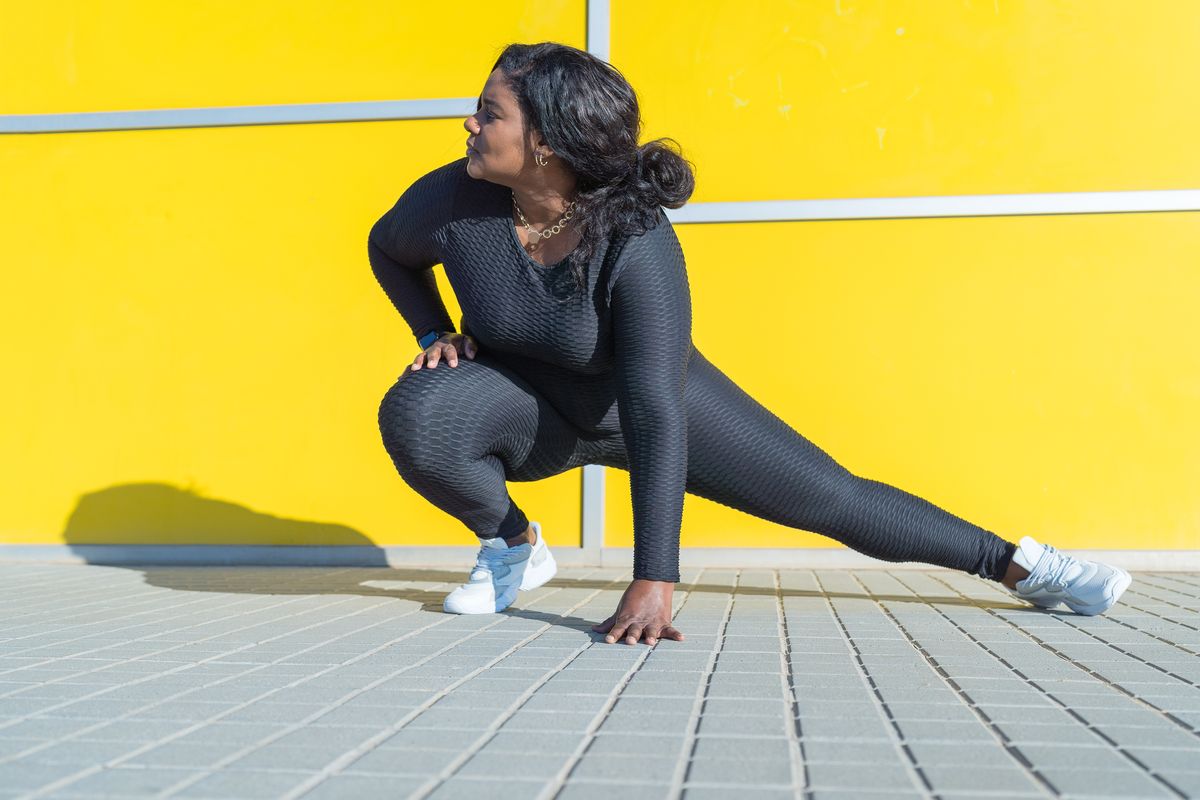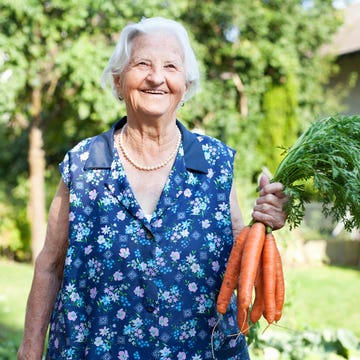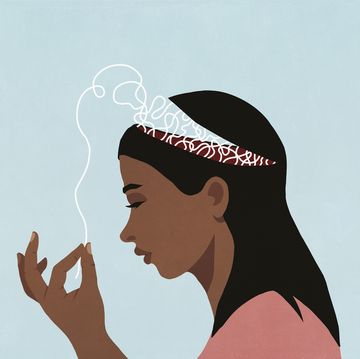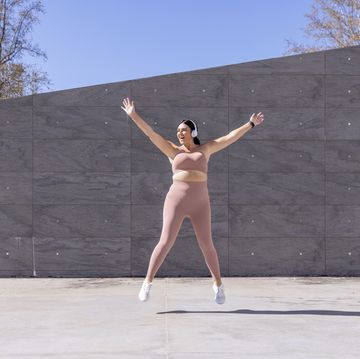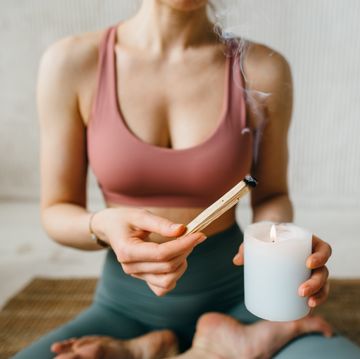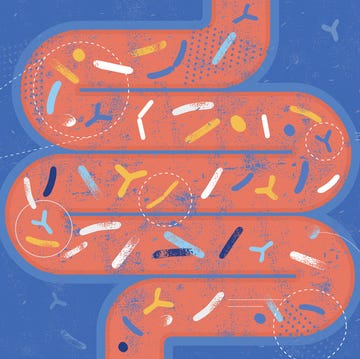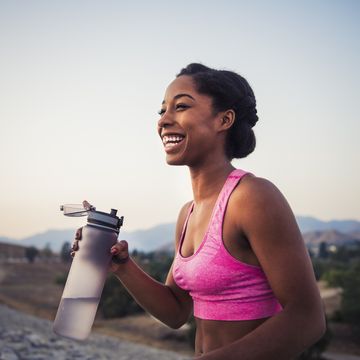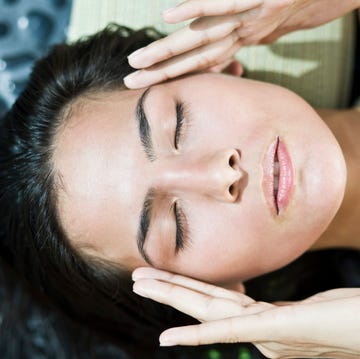If you spent school lunch breaks perfectly forging your mum’s handwriting to get out of PE because it was that time of the month, you’re not alone. But while periods have become less mortifying since the early days of stealthily sneaking an Always pad up your uniform sleeve before going to the loo, their incompatibility with sport persists.
Research conducted last year by ActionAid and YouGov estimated that 6 million British women avoid exercise every year as a result of their period; a statistic showing that whether you’ve skipped your workout in favour of gulping cramp-easing magnesium supps or turned back home on your walk to yoga after leaking through your leggings, your monthly cycle is still a bleeding nuisance when you’re trying to nail your healthy habits.
So, obviously, the idea that your cycle could actually help you hit a new PB feels about as relevant as a PMS joke.
And yet, working with – rather than around – your cycle is a concept that’s only recently gained traction. The English FA introduced its Menstrual Cycle Health Strategy a few years before the Lionesses went on to win Euro 2022.
Then there’s the #SayPeriod campaign, launched by the sports science education platform The Well HQ last year and supported by 50 elite athletes. It aimed to normalise conversations about periods in sport, and these discussions were then published in a book titled The Female Body Bible earlier this year.
Perhaps unsurprisingly, tech is getting in on the game, too. Cycle data features on the Apple Watch, Vodafone’s Player, Whoop and Connect – the first platform that lets athletes view performance and fitness data in the context of their period.
The latter was used by the Welsh Women’s Rugby team to prepare for this year’s Six Nations, and it allowed female players to tailor their exercise, diet and sleep to their cycle – an area that’s been overlooked in sport, says Emma Ross, a physiologist at The Well HQ.
‘There’s an increasing awareness of how understanding the physiology of your cycle can provide real context for how you experience it. I think there might be a shift towards trying to understand the natural cycle in order to reap the benefits of it.’
JUST A PHASE
Central to this trend is cycle mapping, which is sold as a way to adapt your workout routine to the phases of your cycle. Throughout the month, your levels of reproductive hormones oestrogen and progesterone dip and peak, and fluctuations like these may influence your physiology, such as metabolism, mood or energy.
Cycle mapping helps you to understand what these changes feel like in your body and what exercises might feel better at certain times of the month. It’s the reason fitness programmes tell you to lift heavy in your follicular phase (from the first day of your bleed), do HIIT while you’re ovulating (around day 14 of a 28-day cycle) and stretch out in Pilates during the luteal phase (after ovulation, before you get your next bleed). But does the science stack up?
Let’s start with hormones. ‘Research is pretty unequivocal that performance capability is not impacted by menstrual cycle hormones,’ says Dr Ross. Oh. ‘If you can lift 200kg on one day of your cycle, you have the muscular capacity to do that on any other day.’ Indeed, researchers at the University of South Australia found that the menstrual cycle had no clear effect in aerobic, anaerobic or strength-related tests.
Another study noticed that hormonal fluctuations don’t affect neuromuscular function or muscle firing rate – things like jump power, force steadiness and balance. But, this research didn’t look at the effect of menstrual symptoms, such as cramps making you lose sleep, on performance. As such, this is an area that requires more knowledge. Then there’s your mental performance – the idea that workouts can feel harder at certain points in your cycle.
In a 2022 study, researchers from Denmark reported that small reductions in power output just before and during the beginning of participants’ periods were down to shifts in psychological wellbeing, rather than biological changes. Feeling unmotivated, tired, sore and in pain all affect how easy it is to reach peak performance. In that sense, cycle mapping isn’t about performing differently during your cycle, but finding new ways of performing the same.
SQUAD GOALS
Perhaps this is why symptom management is at the heart of efforts to help athletes work with their cycles. ‘It’s hard to imagine a squad of 30 players all doing different things,’ says Georgie Bruinvels, a research scientist and female athlete lead at health tracking app Orreco, on the feasibility of asking athletes to tether their training to their cycle. ‘On the field of play, all athletes have to be capable of being the best on any given day.’
Dr Bruinvels’ team is currently working with The FA to help players do exactly this. ‘We are trying to support and optimise symptoms to enable individuals to train during every part of their cycle,’ says Ritan Mehta, women’s lead performance doctor at The FA.
Their strategy was originally investigated to identify red flags, such as amenorrhea – the loss or cessation of periods. But now, Dr Mehta believes players are gaining a greater understanding of their cycle, its symptoms and when they occur, which is truly empowering.
Symptom management might look like perfectly timing painkillers to avoid the clockwork cramps – a strategy former WH cover star Leah Williamson told us she employed at last years’ Euros tournament. Other solutions are less obvious. ‘I work with a player who gets in their own head and overthinks everything when she’s premenstrual,’ shares Dr Bruinvels.
‘We worked out that, during that time, it’s good for her to listen to a different playlist on the way to training to put her in the right headspace.’ Such interventions might sound simple, but when less than a 1% difference in speed, skill or strength is make or break for an athlete – they matter.
Of course, what works for one person may not work for you – and remembering this, as opposed to following blanket advice, is the most important thing, Dr Bruinvels adds. ‘I actually think it’s disempowering to constantly be told when you will feel bad or when you should pull back from training.’
The worry being that it will become a self-fulfilling prophecy; you’re told you’ll feel lethargic, so you start to feel lethargic. One study that explored the ‘nocebo effect’ – the antithesis to the well-documented placebo effect – on athletic skills, found that receiving negative information about your period can override positive conditioning, leading to physiological repercussions ranging from reduced fatigue threshold right through to impaired motor performance.
LISTEN CLOSELY
What does this all mean for you? When Dr Ross led a cycle mapping study with non-professional users of Jessica Ennis-Hill’s fitness app, Jennis, which creates workouts based on your menstrual phases – users preferred routines that changed with their cycle.
‘One of the biggest things reported back was that they learned to be kind to themselves and were no less fit because of it,’ Dr Ross says. ‘Their negative mood scores also went down because they didn’t have frustration or anxiety over missing workouts or not training right.’
She’s now part of a team from The English Institute of Sport that’s working with the hormone profiler, Hormonix Technology, and engineers at Mint Diagnostics to develop a saliva test that lets athletes measure to-the-minute menstrual cycle hormones.
‘As changes in menstrual cycle hormones are often an indication that something’s going wrong – maybe they’re overtraining or under-fuelling – constantly monitoring lets us act early to prevent injury and illness,’ Dr Ross says.
But there’s much more menstrual ground to cover. Dr Bruinvels believes the luteal phase in particular has been almost exclusively ignored within sports science research, despite this being the phase when menstrual symptoms in athletes are most prevalent.
And while she’d like to see this rectified, it’s a wish that’s couched in the knowledge that, when it comes to our cycles, we may never get the answers we’re looking for. ‘We don’t have that level of certainty in any research area, whether that’s intermittent fasting or training at altitude. We’re all so different, and that includes our menstrual cycles,’ says Dr Bruinvels.
If you find it comforting to know that your motivation being MIA might have more to do with your progesterone than your personality, cycle mapping could be for you. But know that technology can’t possibly monitor the myriad of factors at play when it comes to your period and your athletic performance.
Listening to your body may sound less buzzy, but it might just be your superpower.
Cycle mapping at a glance
Right now, there isn’t enough evidence to justify constantly changing your routine to fit ever-fluctuating hormones. But there are broad-stroke ways to look after your body when oestrogen dominates the first half of your cycle – the follicular phase – and progesterone peaks in the second – the luteal phase.
FOLLICULAR PHASE
Do: strength training
‘Initial studies show that oestrogen creates a really nice environment for tissue growth and repair, meaning it could be beneficial to strength train when levels of the hormone are high,’ says Dr Ross.
‘Building strength when you have the capacity to recover well means less training later in the cycle.’ Researchers found that performing leg-press exercises in the follicular phase increased muscle force and size more than in the luteal phase.
So, push now to create a strength buffer that lets you take the more difficult days slower – without losing your gains.
Eat: carbs
Your body has better blood-sugar control in the follicular phase – meaning fewer energy crashes. Research is looking at whether high-intensity training should occur when your body is best set up for carbohydrates, says Dr Ross. So fuelling up and pushing hard while you feel calm and strong is a good idea.
LUTEAL PHASE
Do: low-intensity or endurance exercise
Most people start noticing negative symptoms after ovulation, when progesterone rises. ‘As progesterone influences blood sugar stability, fuel up on fats – which are also the best energy source for endurance and low-intensity exercise. Shift your movement to longer, slower sessions,’ says Dr Ross. Think: long-distance runs, Pilates or yoga.
Eat: more
‘The physiological process where hormones go from being high to low demands a lot of energy,’ says Dr Bruinvels. In a Psychological Reports study, the calories burned during sleep rose by 7% in the luteal phase. Meet these nutritional needs if you want to reach your goals.
